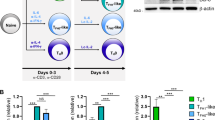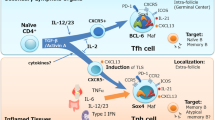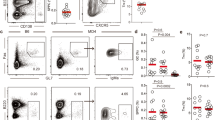Abstract
Lipid antigens trigger help from natural killer T cells (NKT cells) for B cells, and direct conjugation of lipid agonists to antigen profoundly augments antibody responses. Here we show that in vivo, NKT cells engaged in stable and prolonged cognate interactions with B cells and induced the formation of early germinal centers. Mouse and human NKT cells formed CXCR5+PD-1hi follicular helper NKT cells (NKTFH cells), and this process required expression of the transcriptional repressor Bcl-6, signaling via the coreceptor CD28 and interaction with B cells. NKTFH cells provided direct cognate help to antigen-specific B cells that was dependent on interleukin 21 (IL-21). Unlike T cell–dependent germinal centers, those driven by NKTFH cells did not generate long-lived plasma cells. Our results demonstrate the existence of a Bcl-6-dependent subset of NKT cells specialized in providing help to B cells.
This is a preview of subscription content, access via your institution
Access options
Subscribe to this journal
Receive 12 print issues and online access
$209.00 per year
only $17.42 per issue
Buy this article
- Purchase on Springer Link
- Instant access to full article PDF
Prices may be subject to local taxes which are calculated during checkout







Similar content being viewed by others
References
MacLennan, I.C. Germinal centers. Annu. Rev. Immunol. 12, 117–139 (1994).
Vinuesa, C.G., Tangye, S.G., Moser, B. & Mackay, C.R. Follicular B helper T cells in antibody responses and autoimmunity. Nat. Rev. Immunol. 5, 853–865 (2005).
Crotty, S. Follicular helper CD4 T cells (TFH). Annu. Rev. Immunol. 29, 621–663 (2011).
McHeyzer-Williams, L.J., Pelletier, N., Mark, L., Fazilleau, N. & McHeyzer-Williams, M.G. Follicular helper T cells as cognate regulators of B cell immunity. Curr. Opin. Immunol. 21, 266–273 (2009).
Barral, P. et al. B cell receptor-mediated uptake of CD1d-restricted antigen augments antibody responses by recruiting invariant NKT cell help in vivo. Proc. Natl. Acad. Sci. USA 105, 8345–8350 (2008).
Galli, G. et al. CD1d-restricted help to B cells by human invariant natural killer T lymphocytes. J. Exp. Med. 197, 1051–1057 (2003).
Galli, G. et al. Invariant NKT cells sustain specific B cell responses and memory. Proc. Natl. Acad. Sci. USA 104, 3984–3989 (2007).
Leadbetter, E.A. et al. NK T cells provide lipid antigen-specific cognate help for B cells. Proc. Natl. Acad. Sci. USA 105, 8339–8344 (2008).
Godfrey, D.I., Stankovic, S. & Baxter, A.G. Raising the NKT cell family. Nat. Immunol. 11, 197–206 (2010).
Kawano, T. et al. CD1d-restricted and TCR-mediated activation of Vα14 NKT cells by glycosylceramides. Science 278, 1626–1629 (1997).
Cerundolo, V., Silk, J.D., Masri, S.H. & Salio, M. Harnessing invariant NKT cells in vaccination strategies. Nat. Rev. Immunol. 9, 28–38 (2009).
Tonti, E. et al. NKT-cell help to B lymphocytes can occur independently of cognate interaction. Blood 113, 370–376 (2009).
Gumperz, J.E., Miyake, S., Yamamura, T. & Brenner, M.B. Functionally distinct subsets of CD1d-restricted natural killer T cells revealed by CD1d tetramer staining. J. Exp. Med. 195, 625–636 (2002).
Benlagha, K., Kyin, T., Beavis, A., Teyton, L. & Bendelac, A. A thymic precursor to the NK T cell lineage. Science 296, 553–555 (2002).
Pellicci, D.G. et al. A natural killer T (NKT) cell developmental pathway involving a thymus-dependent NK1.1−CD4+ CD1d-dependent precursor stage. J. Exp. Med. 195, 835–844 (2002).
Terashima, A. et al. A novel subset of mouse NKT cells bearing the IL-17 receptor B responds to IL-25 and contributes to airway hyperreactivity. J. Exp. Med. 205, 2727–2733 (2008).
Coquet, J.M. et al. Diverse cytokine production by NKT cell subsets and identification of an IL-17-producing CD4−NK1.1− NKT cell population. Proc. Natl. Acad. Sci. USA 105, 11287–11292 (2008).
Michel, M.L. et al. Identification of an IL-17-producing NK1.1neg iNKT cell population involved in airway neutrophilia. J. Exp. Med. 204, 995–1001 (2007).
Godfrey, D.I. & Kronenberg, M. Going both ways: immune regulation via CD1d-dependent NKT cells. J. Clin. Invest. 114, 1379–1388 (2004).
Cannons, J.L. et al. Optimal germinal center responses require a multistage T cell:B cell adhesion process involving integrins, SLAM-associated protein, and CD84. Immunity 32, 253–265 (2010).
Barral, P. et al. CD169+ macrophages present lipid antigens to mediate early activation of iNKT cells in lymph nodes. Nat. Immunol. 11, 303–312 (2010).
Gammon, G. et al. The choice of T-cell epitopes utilized on a protein antigen depends on multiple factors distant from, as well as at the determinant site. Immunol. Rev. 98, 53–73 (1987).
Haynes, N.M. et al. Role of CXCR5 and CCR7 in follicular Th cell positioning and appearance of a programmed cell death gene-1high germinal center-associated subpopulation. J. Immunol. 179, 5099–5108 (2007).
Lahoud, M.H. et al. Targeting antigen to mouse dendritic cells via Clec9A induces potent CD4 T cell responses biased toward a follicular helper phenotype. J. Immunol. 187, 842–850 (2011).
Sullivan, B.A. et al. Mechanisms for glycolipid antigen-driven cytokine polarization by Vα14i NKT cells. J. Immunol. 184, 141–153 (2010).
Phan, T.G. et al. B cell receptor-independent stimuli trigger immunoglobulin (Ig) class switch recombination and production of IgG autoantibodies by anergic self-reactive B cells. J. Exp. Med. 197, 845–860 (2003).
Crowe, N.Y. et al. Glycolipid antigen drives rapid expansion and sustained cytokine production by NK T cells. J. Immunol. 171, 4020–4027 (2003).
Wilson, M.T. et al. The response of natural killer T cells to glycolipid antigens is characterized by surface receptor down-modulation and expansion. Proc. Natl. Acad. Sci. USA 100, 10913–10918 (2003).
Kerfoot, S.M. et al. Germinal center B cell and T follicular helper cell development initiates in the interfollicular zone. Immunity 34, 947–960 (2011).
Johnston, R.J. et al. Bcl6 and Blimp-1 are reciprocal and antagonistic regulators of T follicular helper cell differentiation. Science 325, 1006–1010 (2009).
Pasquier, B. et al. Defective NKT cell development in mice and humans lacking the adapter SAP, the X-linked lymphoproliferative syndrome gene product. J. Exp. Med. 201, 695–701 (2005).
Dent, A.L., Hu-Li, J., Paul, W.E. & Staudt, L.M. T helper type 2 inflammatory disease in the absence of interleukin 4 and transcription factor STAT6. Proc. Natl. Acad. Sci. USA 95, 13823–13828 (1998).
Linterman, M.A. et al. IL-21 acts directly on B cells to regulate Bcl-6 expression and germinal center responses. J. Exp. Med. 207, 353–363 (2010).
Chung, Y. et al. A critical role of costimulation during intrathymic development of invariant NK T cells. J. Immunol. 180, 2276–2283 (2008).
Uldrich, A.P. et al. NKT cell stimulation with glycolipid antigen in vivo: costimulation-dependent expansion, Bim-dependent contraction, and hyporesponsiveness to further antigenic challenge. J. Immunol. 175, 3092–3101 (2005).
Yabas, M. et al. ATP11C is critical for the internalization of phosphatidylserine and differentiation of B lymphocytes. Nat. Immunol. 12, 441–449 (2010).
Kim, P.J. et al. GATA-3 regulates the development and function of invariant NKT cells. J. Immunol. 177, 6650–6659 (2006).
Araki, K. et al. mTOR regulates memory CD8 T-cell differentiation. Nature 460, 108–112 (2009).
Townsend, M.J. et al. T-bet regulates the terminal maturation and homeostasis of NK and Vα14i NKT cells. Immunity 20, 477–494 (2004).
Matsuda, J.L. et al. T-bet concomitantly controls migration, survival, and effector functions during the development of Vα14i NKT cells. Blood 107, 2797–2805 (2006).
Egawa, T. et al. Genetic evidence supporting selection of the Vα14i NKT cell lineage from double-positive thymocyte precursors. Immunity 22, 705–716 (2005).
Michel, M.L. et al. Critical role of ROR-γt in a new thymic pathway leading to IL-17-producing invariant NKT cell differentiation. Proc. Natl. Acad. Sci. USA 105, 19845–19850 (2008).
Vinuesa, C.G. et al. Germinal centers without T cells. J. Exp. Med. 191, 485–494 (2000).
Qi, H., Cannons, J.L., Klauschen, F., Schwartzberg, P.L. & Germain, R.N. SAP-controlled T-B cell interactions underlie germinal centre formation. Nature 455, 764–769 (2008).
Toellner, K.M. et al. Low-level hypermutation in T cell-independent germinal centers compared with high mutation rates associated with T cell-dependent germinal centers. J. Exp. Med. 195, 383–389 (2002).
Cunningham, A.F. et al. Salmonella induces a switched antibody response without germinal centers that impedes the extracellular spread of infection. J. Immunol. 178, 6200–6207 (2007).
Acknowledgements
We thank the US National Institutes of Health Tetramer Core Facility for the allophycocyanin-conjugated mouse CD1d–α-GalCer tetramer; M. Kronenberg (La Jolla Institute for Allergy and Immunology) for the baculovirus construct; P. Savage (Brigham Young University) for α-GalCer (PBS44); M. Taniguchi (RIKEN Research Center for Allergy and Immunology) for Jα18-deficient mice; M. Townsend for tissue sectioning; X. Hu, M. Srivastava and J. Ellyard for help with some experiments; and M. Pellegrini for infection of mice with L. monocytogenes. Supported by the Sylvia and Charles Viertel Charitable Foundation (C.G.V.), the European Commission (Seventh Framework Programme of the European Commission PIEF-GA-2008-220863 to P.B.), Cancer Research UK (F.D.B. and P.B.), the Royal Society (F.D.B.), the National Health and Medical Research Council of Australia (D.I.G., C.G.V., R.B., C.S.M. and S.G.T.) and the Australian Research Council (A.K.).
Author information
Authors and Affiliations
Contributions
P.-P.C. and P.B. designed, did and analyzed experiments and wrote the manuscript; J.F., C.S.M., A.P., A.K. and J.J.H. did experiments; V.C. and S.G.T. provided intellectual input; R.B., S.L.N. and R.B. provided reagents; D.I.G. provided reagents and intellectual input; and F.D.B. and C.G.V. contributed to the experimental design and analysis and wrote the manuscript.
Corresponding author
Ethics declarations
Competing interests
The authors declare no competing financial interests.
Supplementary information
Supplementary Text and Figures
Supplementary Figures 1–4 (PDF 693 kb)
Supplementary Video 1
Dynamics of NKT cell help to B cells. (MOV 3520 kb)
Rights and permissions
About this article
Cite this article
Chang, PP., Barral, P., Fitch, J. et al. Identification of Bcl-6-dependent follicular helper NKT cells that provide cognate help for B cell responses. Nat Immunol 13, 35–43 (2012). https://doi.org/10.1038/ni.2166
Received:
Accepted:
Published:
Issue Date:
DOI: https://doi.org/10.1038/ni.2166
This article is cited by
-
Zeb2 regulates differentiation of long-lived effector of invariant natural killer T cells
Communications Biology (2023)
-
Developmentally programmed early-age skin localization of iNKT cells supports local tissue development and homeostasis
Nature Immunology (2023)
-
Re-programming mouse liver-resident invariant natural killer T cells for suppressing hepatic and diabetogenic autoimmunity
Nature Communications (2022)
-
Differential location of NKT and MAIT cells within lymphoid tissue
Scientific Reports (2022)
-
Role of NKT cells in cancer immunotherapy—from bench to bed
Medical Oncology (2022)



